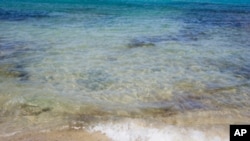Vast reservoirs of fresh water found beneath the ocean floors could potentially be tapped to provide drinking water to parts of the world that face shortages, according to researchers in Australia.
They think the reservoirs, which have been located off Australia, China, North America and South Africa, could hold up to half a million cubic kilometers of “low-salinity” water.
“The volume of this water resource is a hundred times greater than the amount we’ve extracted from the Earth’s subsurface in the past century since 1900,” says lead author Dr. Vincent Post of the National Centre for Groundwater Research and Training (NCGRT) and the School of the Environment at Flinders University.
They say the amounts could sustain some regions of the world for decades and stave off, at least temporarily, a global water crisis.
These reserves formed over the past hundreds of thousands of years when on average the sea level was much lower than it is today, and when the coastline was further out, said Post.
“So when it rained, the water would infiltrate into the ground and fill up the water table in areas that are nowadays under the sea,” he said. “It happened all around the world, and when the sea level rose when ice caps started melting some 20,000 years ago, these areas were covered by the ocean.
He added that many of the aquifers are protected from seawater by layers of clay and sediment that sit on top of them.
The aquifers are similar to those below land, which much of the world relies on for drinking water. Their salinity is low enough for them to be turned into potable water, Post said.
Getting to the water could be expensive, however.
“There are two ways to access this water – build a platform out at sea and drill into the seabed, or drill from the mainland or islands close to the aquifers,” said Post.
While offshore drilling can be very costly, he said this source of freshwater should be assessed and considered in terms of cost, sustainability and environmental impact against other water sources such as desalination, or even building large new dams on land.
“Freshwater under the seabed is much less salty than seawater,” said Post. “This means it can be converted to drinking water with less energy than seawater desalination, and it would also leave us with a lot less hyper-saline water.”
Post also warns that these newly discovered aquifers are non-renewable.
“We should use them carefully – once gone, they won’t be replenished until the sea level drops again, which is not likely to happen for a very long time.”
They think the reservoirs, which have been located off Australia, China, North America and South Africa, could hold up to half a million cubic kilometers of “low-salinity” water.
“The volume of this water resource is a hundred times greater than the amount we’ve extracted from the Earth’s subsurface in the past century since 1900,” says lead author Dr. Vincent Post of the National Centre for Groundwater Research and Training (NCGRT) and the School of the Environment at Flinders University.
They say the amounts could sustain some regions of the world for decades and stave off, at least temporarily, a global water crisis.
These reserves formed over the past hundreds of thousands of years when on average the sea level was much lower than it is today, and when the coastline was further out, said Post.
“So when it rained, the water would infiltrate into the ground and fill up the water table in areas that are nowadays under the sea,” he said. “It happened all around the world, and when the sea level rose when ice caps started melting some 20,000 years ago, these areas were covered by the ocean.
He added that many of the aquifers are protected from seawater by layers of clay and sediment that sit on top of them.
The aquifers are similar to those below land, which much of the world relies on for drinking water. Their salinity is low enough for them to be turned into potable water, Post said.
Getting to the water could be expensive, however.
“There are two ways to access this water – build a platform out at sea and drill into the seabed, or drill from the mainland or islands close to the aquifers,” said Post.
While offshore drilling can be very costly, he said this source of freshwater should be assessed and considered in terms of cost, sustainability and environmental impact against other water sources such as desalination, or even building large new dams on land.
“Freshwater under the seabed is much less salty than seawater,” said Post. “This means it can be converted to drinking water with less energy than seawater desalination, and it would also leave us with a lot less hyper-saline water.”
Post also warns that these newly discovered aquifers are non-renewable.
“We should use them carefully – once gone, they won’t be replenished until the sea level drops again, which is not likely to happen for a very long time.”








